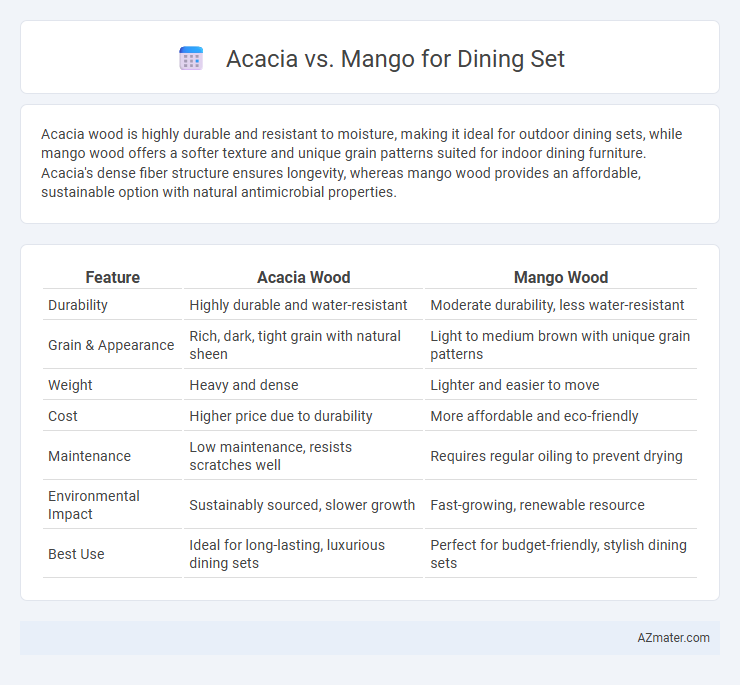Acacia wood is highly durable and resistant to moisture, making it ideal for outdoor dining sets, while mango wood offers a softer texture and unique grain patterns suited for indoor dining furniture. Acacia's dense fiber structure ensures longevity, whereas mango wood provides an affordable, sustainable option with natural antimicrobial properties.
Table of Comparison
| Feature | Acacia Wood | Mango Wood |
|---|---|---|
| Durability | Highly durable and water-resistant | Moderate durability, less water-resistant |
| Grain & Appearance | Rich, dark, tight grain with natural sheen | Light to medium brown with unique grain patterns |
| Weight | Heavy and dense | Lighter and easier to move |
| Cost | Higher price due to durability | More affordable and eco-friendly |
| Maintenance | Low maintenance, resists scratches well | Requires regular oiling to prevent drying |
| Environmental Impact | Sustainably sourced, slower growth | Fast-growing, renewable resource |
| Best Use | Ideal for long-lasting, luxurious dining sets | Perfect for budget-friendly, stylish dining sets |
Introduction to Acacia and Mango Wood
Acacia wood is known for its durability, unique grain patterns, and rich, warm tones, making it a popular choice for dining sets that require both strength and aesthetic appeal. Mango wood is prized for its sustainability, smooth texture, and variation in color from light to dark shades, providing a stylish and eco-friendly option for dining furniture. Both hardwoods offer distinct characteristics that influence the longevity and appearance of dining sets, with Acacia favoring robustness and Mango emphasizing environmental benefits.
Key Characteristics of Acacia Wood
Acacia wood, known for its durability and rich, warm tones, offers excellent resistance to scratches and water, making it ideal for dining sets that endure daily use. Its dense grain and natural oils help prevent decay and insect damage, ensuring long-lasting furniture with minimal maintenance. Acacia also provides a unique, rustic aesthetic with striking grain patterns that add character and elegance to any dining space.
Key Characteristics of Mango Wood
Mango wood for dining sets is prized for its sustainability, dense grain, and rich color variations ranging from light to dark brown with occasional streaks. Its natural hardness and durability make it resistant to wear and ideal for everyday use, while the wood's smooth texture allows for elegant finishes. Compared to acacia, mango wood offers a more vibrant appearance and is often more affordable, appealing to eco-conscious consumers seeking stylish yet functional furniture.
Durability Comparison: Acacia vs Mango
Acacia wood offers superior durability for dining sets due to its dense grain structure and high natural resistance to scratches, moisture, and decay, making it ideal for long-term use. Mango wood, while also durable and sustainable, tends to be softer and more prone to dents and surface wear over time compared to acacia. For households seeking a robust, low-maintenance dining set that withstands heavy daily use, acacia wood is generally the more resilient choice.
Sustainability and Environmental Impact
Acacia wood is highly sustainable due to its fast growth rate and natural resistance to pests, making it an eco-friendly choice for dining sets that requires minimal chemical treatments. Mango wood, sourced from mature mango trees no longer producing fruit, promotes recycling of timber and reduces deforestation compared to other hardwoods, contributing positively to environmental conservation. Both woods are biodegradable and carbon-neutral over their lifecycle, but acacia's rapid renewability often results in a lower environmental footprint.
Aesthetic Differences: Grain and Color
Acacia dining sets feature a rich, warm color palette with deep, reddish-brown hues and a pronounced, swirling grain pattern that adds natural elegance and character. Mango wood dining sets showcase a lighter, golden to honey-toned color with a more uniform, subtle grain, offering a modern and clean aesthetic. The contrasting grain textures and color tones between acacia's bold, intricate patterns and mango's smooth, understated finish cater to different design preferences and interior styles.
Maintenance and Care Requirements
Acacia dining sets require regular oiling to maintain their natural finish and prevent drying or cracking, while mango wood furniture benefits from occasional polishing to preserve its rich color and swirled grain patterns. Both woods are durable but acacia is more resistant to moisture and insect damage, making it slightly easier to maintain in humid environments. Cleaning should be done with a soft cloth and mild soap for both materials, avoiding harsh chemicals that can damage the wood's surface.
Price and Availability
Acacia dining sets generally come with a higher price tag due to their durable hardwood quality and rich grain patterns, typically ranging from $800 to $2,500. Mango wood dining sets are more affordable, often priced between $500 and $1,500, making them a popular choice for budget-conscious buyers. Both materials are widely available through furniture retailers and online marketplaces, but acacia sets may have limited stock depending on regional demand and sourcing.
Best Uses for Acacia and Mango in Dining Sets
Acacia wood offers exceptional durability and resistance to scratches, making it ideal for outdoor dining sets exposed to weather and heavy use. Mango wood's smooth grain and rich color variations enhance indoor dining furniture with a warm, rustic aesthetic, while providing stability and eco-friendliness. Choosing acacia ensures longevity for high-traffic dining areas, whereas mango wood excels in stylish, comfortable indoor settings.
Choosing the Right Wood for Your Dining Set
Acacia wood offers durability, natural resistance to moisture, and striking grain patterns, making it ideal for dining sets in high-traffic areas or homes prone to humidity. Mango wood provides a sustainable option with a smooth texture and varied tones, blending elegance with eco-friendliness for stylish dining furniture. Selecting the right wood depends on factors like hardness, maintenance, and aesthetic preference, with Acacia excelling in longevity and Mango standing out for affordability and unique character.

Infographic: Acacia vs Mango for Dining Set
 azmater.com
azmater.com